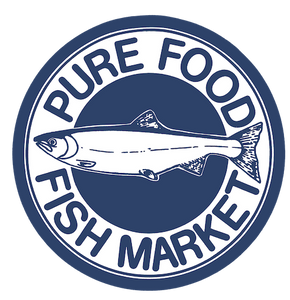FRESH BLOG
For all things Fresh Seafood, cooking inspiration, and more!

Good Earth, Good Water
For the discriminating foodie, three shopping meccas By Ronald Holden
A fundamental truth underlies everything about food: unless you grow it, raise it or catch it yourself, you need a marketplace in which to find it. Even if you bake your own bread, you still need to buy flour; if you raise tomatoes in the backyard or a pot of herbs on the windowsill, you still need to buy salt and pepper.
One of the reasons Seattle has become such a great food community is its abundance of raw materials: seafood, mushrooms, fruit, clean water. Add to that the hardworking farmers, fishermen and foragers, and the well-established networks for getting the ingredients of their goodness into the hands of buyers. In short: we've become a city of great marketplaces.
We'll look at traditional, small-scale farmers' markets in upcoming issues. For a start, though, a stroll through three of Seattle's biggest and most colorful.
-Pike Place Market-
About to celebrate its 100th anniversary, Seattle's iconic Pike Place Market nearly didn't make it to the age of 70. Its warren of stalls, shops and independent vendors didn't fit in with developers' plans for the neighborhood, and it was slated for demolition.
In France, at roughly the same time, that very fate befell Les Halles, the center-city market that Zola called "the belly of Paris." But in Seattle, the market that the painter Mark Tobey called "the soul of Seattle" survived, thanks to a campaign waged by the architect Victor Steinbrueck. (His son, City Councilman Peter Steinbrueck, is currently trying to make sure there's no rebuild of the Alaskan Way Viaduct.) The Market was placed under the watchful eye of a municipal Preservation and Development Authority, which sets policy for its permanent vendors, allocates space to a long roster of day vendors, and organizes social services for the several hundred people who live in the market's low-income housing.
Sol Amon, from his crowded perch overlooking Pure Food Fish, surveys a narrow but busy stall perhaps 200 steps from the Market's iconic Pig. It's not the seafood vendor where they fling the fish for TV cameras and gawking tourists, it's the one that's been in business for 45 years. Sol was named King of the Market a year ago, an honor that he takes in stride. One of his employees, Richard Hoague, has been

Delicious City Editorial Director Ronald Holden at Pure Food Fish - Photos by J. Cody Lucido
At its heart, Pike Place remains a traditional farmers' market. Along the so-called low stalls, farm families from Auburn and Enumclaw sell home-grown vegetables. Many are Hmong refugees from the mountains of Cambodia. They also provide flowers and ornamental plants.
Intermingled with the farmers are the artists, artisans and crafts people, offering tastes of honey and nuts, hawking T-shirts, hand-painted ceramics, scrimshaw, leather, jewelry, hand-printed postcards. Below street level are dozens of shops selling vintage posters, vintage clothing, vintage books. All this, of course, without a single Safeway or McDonald's. So, a naïve visitor might wonder, how does the Market tolerate a Starbucks? Ah, but this is where Starbucks was conceived, born and nurtured! This is ground zero, this warm petri dish of supportive small businesses.
One cannot imagine Seattle today without the Pike Place Market at its core. Let the Space Needle serve as Seattle's symbol; the Market is its living, beating heart.
Seattle-based food, wine and travel writer Ronald Holden is DeliciousCity's editorial director. His Tasting Notes and Culinary Dispatches at cornichon.org was named one of the Internet's "Top Ten Food Blogs" last year by About.com.
Issue #0 - April 2007
Photos by J. Cody Lucido

